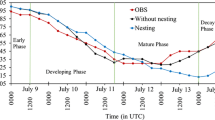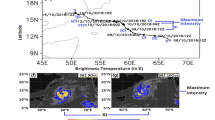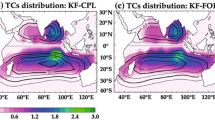Abstract
The influences of the tropical cyclones (TCs) on the ocean heat content (OHC) of the South China Sea (SCS) was investigated by observations and numerical simulations. Ensemble analyses based on observations showed notable differences in OHC changes caused by TCs with different tracks: (1) TCs which generated over the western North Pacific (WNP) and did not enter the SCS (TC-P) decreased the OHC mainly in the central SCS while increasing the OHC in southern SCS and coastal areas along South China; (2) TCs which generated over the WNP and entered the SCS (TC-PS) decreased the OHC in most of the SCS beyond the coastal areas with a higher amplitude than that caused by TC-P; and (3) TCs which generated over the SCS (TC-S) induced the strongest OHC decrease and a distinct OHC increase in the southeastern SCS and Sulu Sea (SS). The distinct response of the SCS OHC was mainly attributed to the different surface heat fluxes and oceanic transports caused by TCs. Strong surface heat flux proximal to TC tracks led to ocean heat release to the atmosphere and decreased the OHC in these areas, while the oceanic current caused by the TC cyclonic wind field transported the OHC to areas distant from the TC center. Eastward transport of the OHC south of 15° N increased the OHC in the southeastern SCS and SS. These results expressed the detailed response of the OHC to TCs with different tracks over the WNP and SCS, and clarified the influences of TCs on the ocean environments of the SCS and for predicting the changes in the SCS.











Similar content being viewed by others
References
Andreas, E. L., & Emanuel, K. A. (2001). Effects of sea spray on tropical cyclone intensity. Journal of the atmospheric sciences, 58(24), 3741–3751.
Bentamy, A., & Croize-Fillon, D. (2015). Daily ASCAT surface wind fields. IFREMER Technology Report, Laboratoire d'Oceanographie Spatiale, France.
Carton, J. A., & Giese, B. S. (2008). A reanalysis of ocean climate using Simple Ocean Data Assimilation (SODA). Monthly Weather Review, 136(8), 2999–3017.
Close, S. E., Naveira Garabato, A. C., McDonagh, E. L., King, B. A., Biuw, M., & Boehme, L. (2013). Control of mode and intermediate water mass properties in Drake Passage by the Amundsen Sea Low. Journal of Climate, 26(14), 5102–5123.
Donahue, D., 2015. Us doc/NOAA national environmental satellite data and information service. satellite ocean heat content suite. NOAA national centers for environmental information. dataset. URL: https://data.nodc.noaa.gov/cgi-bin/iso?id=gov.noaa.nodc:NESDIS-OHC.
Dudhia, J. (1989). Numerical study of convection observed during the winter monsoon experiment using a mesoscale two-dimensional model. Journal of the atmospheric sciences, 46(20), 3077–3107.
Dunstone, N. J., Smith, D. M., & Eade, R. (2011). Multi‐year predictability of the tropical Atlantic atmosphere driven by the high latitude North Atlantic Ocean. Geophysical Research Letters, 38(14).
Emanuel, K. A. (1986). An air-sea interaction theory for tropical cyclones. Part I: Steady-state maintenance. Journal of the Atmospheric Sciences, 43(6), 585–605.
Emanuel, K. A. (1999). Thermodynamic control of hurricane intensity. Nature, 401(6754), 665.
Emanuel, K. A. (2001). Contribution of tropical cyclones to meridional heat transport by the oceans. Journal of Geophysical Research: Atmospheres, 106(D14), 14771–14781.
Feng, J., & Hu, D. (2014). How much does heat content of the western tropical Pacific Ocean modulate the South China Sea summer monsoon onset in the last four decades? Journal of Geophysical Research: Oceans, 119(7), 4029–4044.
Gao, L., Rintoul, S. R., & Yu, W. (2018). Recent wind-driven change in Subantarctic Mode Water and its impact on ocean heat storage. Nature Climate Change, 8(1), 58.
Garabato, A. C. N., Jullion, L., Stevens, D. P., Heywood, K. J., & King, B. A. (2009). Variability of Subantarctic Mode Water and Antarctic Intermediate Water in the Drake Passage during the late-twentieth and early-twenty-first centuries. Journal of Climate, 22(13), 3661–3688.
Giese, B. S., & Ray, S. (2011). El Niño variability in simple ocean data assimilation (SODA), 1871–2008. Journal of Geophysical Research: Oceans, 116(C2).
He, H., Wu, Q., Chen, D., Sun, J., Liang, C., Jin, W., & Xu, Y. (2018). Effects of surface waves and sea spray on air–sea fluxes during the passage of Typhoon Hagupit. Acta Oceanologica Sinica, 37(5), 1–7.
Hong, S. Y., & Lim, J. O. J. (2006). The WRF single-moment 6-class microphysics scheme (WSM6). Asia-Pacific Journal of Atmospheric Sciences, 42(2), 129–151.
Hong, X., Chang, S. W., Raman, S., Shay, L. K., & Hodur, R. (2000). The interaction between Hurricane Opal (1995) and a warm core ring in the Gulf of Mexico. Monthly Weather Review, 128(5), 1347–1365.
Hui, Z., & Xu, Y. (2016). The impact of wave-induced Coriolis Stokes forcing on satellite-derived ocean surface currents. Journal of Geophysical Research: Oceans, 121(1), 410–426.
Jacob, S. D., Shay, L. K., Mariano, A. J., & Black, P. G. (2000). The 3D oceanic mixed layer response to Hurricane Gilbert. Journal of Physical Oceanography, 30(6), 1407–1429.
Jansen, M., & Ferrari, R. (2009). Impact of the latitudinal distribution of tropical cyclones on ocean heat transport. Geophysical Research Letters, 36(6).
Kain, J. S. (2004). The Kain-Fritsch convective parameterization: an update. Journal of applied meteorology, 43(1), 170–181.
Kalnay, E., Kanamitsu, M., Kistler, R., Collins, W., Deaven, D., Gandin, L., & Zhu, Y. (1996). The NCEP/NCAR 40-year reanalysis project. Bulletin of the American meteorological Society, 77(3), 437–472.
Korty, R. L., Emanuel, K. A., & Scott, J. R. (2008). Tropical cyclone–induced upper-ocean mixing and climate: Application to equable climates. Journal of Climate, 21(4), 638–654.
Lagerloef, G. S., Mitchum, G. T., Lukas, R. B., & Niiler, P. P. (1999). Tropical Pacific near-surface currents estimated from altimeter, wind, and drifter data. Journal of Geophysical Research: Oceans, 104(C10), 23313–23326.
Lin, I. I., Liu, W. T., Wu, C. C., Chiang, J. C., & Sui, C. H. (2003). Satellite observations of modulation of surface winds by typhoon‐induced upper ocean cooling. Geophysical research letters, 30(3).
Ling, Z., Wang, G., Wang, C., & Fan, Z. S. (2011). Different effects of tropical cyclones generated in the South China Sea and the northwest Pacific on the summer South China Sea circulation. Journal of oceanography, 67(3), 347–355.
Ma, Y., Zhang, S., Qi, Y., & Jing, Z. (2019). Upper ocean near-inertial response to the passage of two sequential typhoons in the northwestern South China Sea. Science China Earth Sciences, 62(5), 863–871.
Mei, W., Primeau, F., McWilliams, J. C., & Pasquero, C. (2013). Sea surface height evidence for long-term warming effects of tropical cyclones on the ocean. Proceedings of the National Academy of Sciences, 110(38), 15207–15210.
Mlawer, E. J., Taubman, S. J., Brown, P. D., Iacono, M. J., & Clough, S. A. (1997). Radiative transfer for inhomogeneous atmospheres: RRTM, a validated correlated-k model for the longwave. Journal of Geophysical Research: Atmospheres, 102(D14), 16663–16682.
NCEP, 2000. NCEP fnl operational model global tropospheric analyses, continuing from July 1999. URL: https://doi.org/https://doi.org/10.5065/D6M043C6.
Pasquero, C., & Emanuel, K. (2008). Tropical cyclones and transient upper-ocean warming. Journal of Climate, 21(1), 149–162.
Paulson, C. A. (1970). The mathematical representation of wind speed and temperature profiles in the unstable atmospheric surface layer. Journal of Applied Meteorology, 9(6), 857–861.
Price, J. F. (1981). Upper ocean response to a hurricane. Journal of Physical Oceanography, 11(2), 153–175.
Price, J. F., Sanford, T. B., & Forristall, G. Z. (1994). Forced stage response to a moving hurricane. Journal of Physical Oceanography, 24(2), 233–260.
Rintoul, S. R., & England, M. H. (2002). Ekman transport dominates local air–sea fluxes in driving variability of Subantarctic Mode Water. Journal of Physical Oceanography, 32(5), 1308–1321.
Robson, J. I., Sutton, R. T., & Smith, D. M. (2012). Initialized decadal predictions of the rapid warming of the North Atlantic Ocean in the mid 1990s. Geophysical Research Letters, 39(19).
Sallée, J. B., Speer, K. G., & Rintoul, S. R. (2010). Zonally asymmetric response of the Southern Ocean mixed-layer depth to the Southern Annular Mode. Nature Geoscience, 3(4), 273.
Skamarock, W. C., Klemp, J. B., Dudhia, J., Gill, D. O., Barker, D. M., Wang, W., & Powers, J. G. (2008). A description of the Advanced Research WRF version 3. NCAR Technical note-475+ STR.
Sriver, R. L., Goes, M., Mann, M. E., & Keller, K. (2010). Climate response to tropical cyclone‐induced ocean mixing in an Earth system model of intermediate complexity. Journal of Geophysical Research: Oceans, 115(C10).
Sriver, R. L., & Huber, M. (2007). Observational evidence for an ocean heat pump induced by tropical cyclones. Nature, 447(7144), 577.
Sun, J., Wang, D., Hu, X., Ling, Z., & Wang, L. (2019). Ongoing Poleward Migration of Tropical Cyclone Occurrence Over the Western North Pacific Ocean. Geophysical Research Letters, 46(15), 9110–9117.
Sun, J., Wang, G., Zuo, J., Ling, Z., & Liu, D. (2017). Role of surface warming in the northward shift of tropical cyclone tracks over the South China Sea in November. Acta Oceanologica Sinica, 36(5), 67–72.
Tao, W. K., Shi, J. J., Chen, S. S., Lang, S., Lin, P. L., Hong, S. Y., & Hou, A. (2011). The impact of microphysical schemes on hurricane intensity and track. Asia-Pacific Journal of Atmospheric Sciences, 47(1), 1–16.
Venugopal, T., Ali, M. M., Bourassa, M. A., Zheng, Y., Goni, G. J., Foltz, G. R., & Rajeevan, M. (2018). Statistical Evidence for the Role of Southwestern Indian Ocean Heat Content in the Indian Summer Monsoon Rainfall. Scientific reports, 8(1), 12092.
Vincent, E. M., Madec, G., Lengaigne, M., Vialard, J., & Koch-Larrouy, A. (2013). Influence of tropical cyclones on sea surface temperature seasonal cycle and ocean heat transport. Climate dynamics, 41(7–8), 2019–2038.
Wada, A., & Chan, J. C. L. (2008). Relationship between typhoon activity and upper ocean heat content. Geophysical Research Letters, 35(17).
Wada, A., Niino, H., & Nakano, H. (2009). Roles of vertical turbulent mixing in the ocean response to Typhoon Rex (1998). Journal of oceanography, 65(3), 373–396.
Wang, G., Su, J., Ding, Y., & Chen, D. (2007). Tropical cyclone genesis over the South China Sea. Journal of Marine Systems, 68(3–4), 318–326.
Wang, G., Wu, L., Johnson, N. C., & Ling, Z. (2016). Observed three-dimensional structure of ocean cooling induced by Pacific tropical cyclones. Geophysical Research Letters, 43(14), 7632–7638.
Wang, X., Wang, C., Han, G., Li, W., & Wu, X. (2014). Effects of tropical cyclones on large-scale circulation and ocean heat transport in the South China Sea. Climate dynamics, 43(12), 3351–3366.
Wu, L., Wang, B., & Geng, S. (2005). Growing typhoon influence on East Asia. Geophysical Research Letters, 32(18).
Wu, R., Zhang, H., Chen, D., Li, C., & Lin, J. (2018). Impact of Typhoon Kalmaegi (2014) on the South China Sea: Simulations using a fully coupled atmosphere-ocean-wave model. Ocean Modelling, 131, 132–151.
Zhang, H., Chen, D., Zhou, L., Liu, X., Ding, T., & Zhou, B. (2016). Upper ocean response to typhoon Kalmaegi (2014). Journal of Geophysical Research: Oceans, 121(8), 6520–6535.
Acknowledgements
This work was supported by the Basic Scientific Fund for National Public Research Institutes of China (2020Q05), the National Natural Science Foundation of China (41706034 and 41376038), Laboratory for Regional Oceanography and Numerical Modeling, Qingdao National Laboratory for Marine Science and Technology (2019A02); National Science and Technology Major Project (2016ZX05057015), National Programme on Global Change and Air-Sea Interaction (GASI-03-01-01-02 and GASI-IPOVAI-01-05), and NSFC-Shandong Joint Fund for Marine Science Research Centers (U1606405).
Author information
Authors and Affiliations
Corresponding author
Additional information
Publisher's Note
Springer Nature remains neutral with regard to jurisdictional claims in published maps and institutional affiliations.
Rights and permissions
About this article
Cite this article
Yu, L., Sun, J., Hui, Z. et al. The Ocean Heat Content Changes in the South China Sea due to Tropical Cyclones with Different Tracks. Pure Appl. Geophys. 178, 269–286 (2021). https://doi.org/10.1007/s00024-020-02630-w
Received:
Revised:
Accepted:
Published:
Issue Date:
DOI: https://doi.org/10.1007/s00024-020-02630-w




